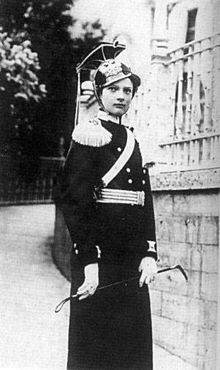 Tatiana Nicholaevna was the second child of Alexandra and Nicholas. She was only 18 months younger than her older sister Olga, and was considered the most beautiful of the four grand duchesses. Tatiana was also the leader of OTMA, mostly because she got along the best with Alexandra. She most resembled her mother and often was sent to Alexandra by her sisters when they wanted something. She was assigned a regiment of soldiers - and her uniform that she is wearing, below, survived to this day (I saw it in Cincinnati a few years ago!).
Tatiana Nicholaevna was the second child of Alexandra and Nicholas. She was only 18 months younger than her older sister Olga, and was considered the most beautiful of the four grand duchesses. Tatiana was also the leader of OTMA, mostly because she got along the best with Alexandra. She most resembled her mother and often was sent to Alexandra by her sisters when they wanted something. She was assigned a regiment of soldiers - and her uniform that she is wearing, below, survived to this day (I saw it in Cincinnati a few years ago!).In 1913 Russia cele
 brated the Tercentenary - 300 years of Romanov rule. Formal pictures were taken of the imperial family. These photos are perhaps the most famous and well-known pictures of the Romanovs. But poor Tatiana had just recovered from typhoid and had lost all her hair - so she wore a wig for the photos.
brated the Tercentenary - 300 years of Romanov rule. Formal pictures were taken of the imperial family. These photos are perhaps the most famous and well-known pictures of the Romanovs. But poor Tatiana had just recovered from typhoid and had lost all her hair - so she wore a wig for the photos.During World War I, Tatiana worked as a Red Cross nurse with Olga and Alexandra. She was the most social of her sisters, and both Anna Vyrubova and Lili Dehn, beloved friends of Alexandra, wrote after the revolution how Tatiana wished to have friends outside their small social circle, but Alexandra would never allow it.
When the family was held captive in
 Tobolsk, it was Tatiana whom Alexandra chose to remain in charge of Alexei, Olga and Anastasia, while she and Marie accompanied Nicholas to Ekaterinburg. The final entry in Tatiana's diary, copied from a Russian holy man read ominously: "Your grief is indescribable, the Savior's grief in the Gardens of Gethsemane the world's sins is immeasurable, join your grief to his, in it you will find consolation."
Tobolsk, it was Tatiana whom Alexandra chose to remain in charge of Alexei, Olga and Anastasia, while she and Marie accompanied Nicholas to Ekaterinburg. The final entry in Tatiana's diary, copied from a Russian holy man read ominously: "Your grief is indescribable, the Savior's grief in the Gardens of Gethsemane the world's sins is immeasurable, join your grief to his, in it you will find consolation."Olga and Tatiana, taken in 1913 as part of the Tercentenary celebrations. Tatiana is wearing a wig!






